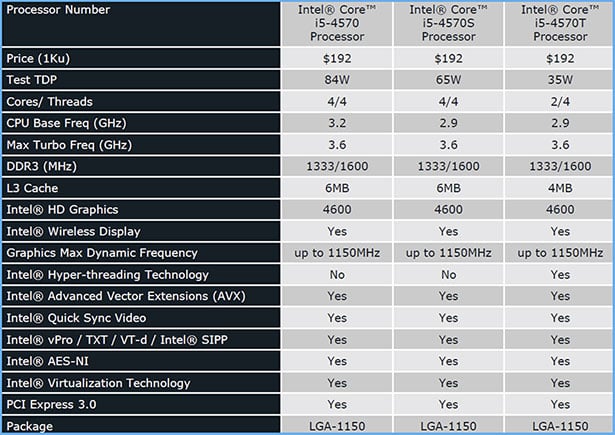Intel Core i7-4770K Review: Haswell Has Landed
4th Gen Intel Core Processor Lineup
As you probably expect, Intel’s got a host of Haswell-based 4th Generation Core processors coming down the pipe. We’ll have more new to share with you soon regarding mobile and dual-core parts, but here’s a breakdown of the desktop quad-core parts that are on the immediate horizon.
This first batch of Core i5 processors all offer the same max Turbo frequency of 3.6GHz and feature the same on-die Intel HD 4600 series graphics as the Core i7-4770K we’ll be showing you here. Note, however, that the maximum graphics frequency of these Core i5 parts of 1150MHz is a full 100MHz below the 4770K. HyperThreading is not supported on the true quad-core chips, but it is on the dual-core Core i5-4570T (far right). TDPs range from 35w to 84w.
This next batch of Core i5 processors are all quad-core parts, with the same cache and graphics configurations. The only differences between these chips are their base and max Turbo frequencies and their test TDPs. The K-SKU is also fully unlocked for easier and more flexible overclocking. These processors also feature Intel HD 4600 series graphics, but with a maximum GPU frequency of 1200MHz.
And here we have Intel’s 4th Generation Core i7 processor line-up at launch. All of these processors are quad-core parts with support for HyperThreading. The Core i7-4770K is the enthusiast targeted product with unlocked multipliers, and for some inexplicable reason, vPro features disabled. Also note that the Core i7-4770R is the only chip here with Iris-branded graphics. The Core i7-4770R features Intel Iris Pro 5200 series graphics with a max GPU frequency of 1300MHz. The rest of the i7 desktop processors have Intel HD 4600 series graphics with support for max frequencies in the 1200MHz -1250MHz.

The Single-Chip Intel 4th Gen Y-Processor
Intel will also be offering a single-chip 4th Generation Core processor with the CPU and PCH integrated into single BGA package. The 4th Gen Core Y-Processor line as it’ll be known will include 15W and 28W TDPs, with S0ix support, and supports LPDDR3 and DDR3L memory. These chips are designed for Ultra-Thin devices smaller form factors.









